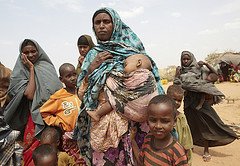In recent months, the Horn of Africa – and especially Somalia – have been making front page news because of the famine gripping the region. The statistics are staggering:
-More than 12 million people are affected by the drought in the region and require humanitarian assistance, including 4 million Somalis which the UN considers “in crisis”
-750,000 people are at risk of death in the next four months – including 400,000 children
-Estimates indicate that tens of thousands of people – mostly children – have already died from hunger
– 100,000 IDPs have moved into Mogadishu in the last 2 months
-While substantial donations have already been made, the UN appeal is still short approximately $1 billion
A crisis of regional proportions with global roots and local factors
The New York Times has a couple of great graphics that show the scale of the unfolding crisis:


Delivering aid to those who need it most in Somalia
The situation in Somalia is alarming, though almost all accounts are sent from the capital, the only part of the country accessible to aid organizations and media. In The Guardian, the international president of Médecins Sans Frontières (MSF), Dr Unni Karunakara notes that while MSF has been able to assist in refugees camps in Ethiopia and Kenya, it is very difficult for the organization to reach the “epicenter of the crisis” in Somalia. He notes, soberly: “We may have to live with the reality that we may never be able to reach the communities most in need of help.”
The Shabab militant group, which controls most of the region where famine is occuring in Somalia, has shown a lot of hostility towards Western aid agencies and effectively prevented aid from reaching people in dire need. Swaths of territory are out of reach for food aid, health care and humanitarian assistance, forcing people to essentially flee or die. Those who manage to escape Shabab strongholds wind up in Mogadishu or refugee camps across the border in terrible health conditions. The challenge for aid agencies is to be able to reach those in need. With hundreds of thousands of people on the move and the inherent danger of operating in Shabab-controlled areas, an effective humanitarian response seems practically impossible.
In addition to the enormous logistical and security challenges associated with delivering aid in this unstable part of the world, local systems of distribution are also affected by corruption and theft. The United Nations World Food Program, which relies on local contractors for the distribution of food aid in Somalia, is currently investigating claims that “thousands of sacks of grain and other supplies” have been stolen and resold on the market. Both the New York Times and Al-Jazeera report that food is still available in Mogadishu, but that prices have tripled in the past year, making food unaffordable. Some suggest beginning air lifts into areas that are out of reach, and setting up more decentralized systems of aid distribution outside of refugee camps, in areas currently cut off from aid. Others, like MSF’s Dr. Karunakara, seem to believe that there are real limits to the effectiveness of humanitarian aid in Somalia.
Now is the time to prevent the next crisis
Beyond urgently dealing with the immediate consequences of the present crisis, many are calling for more attention to be given to the underlying factors that make communities and countries vulnerable to environmental shocks. Insecurity, poor governance, local and regional conflicts weaken Somalian agricultural production and food supply, and communities do not have the resources – loans, credit, infrastructure, inputs, social services – to deal with drought. Not only should governments and the international community respond much sooner – before a famine situation is actually declared – but, as I’ve written here before, investment in strengthening regional and local food production systems as well as measures to stabilize food markets are critical. These types of policies and programs go hand in hand with a firm resolve to address the root causes of chronic poverty. Given Shabab’s control of key parts of Somalia and structural corruption in the aid system, this may be extremely difficult to achieve in the short run. Acknowledging these obstacles, however, is a first step towards rethinking an approach to humanitarian and development aid in this troubled part of the world.
